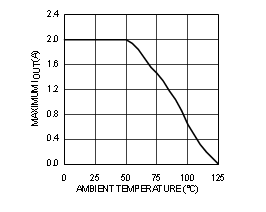SNVS737F October 2011 – June 2019 LMR24220
PRODUCTION DATA.
- 1 Features
- 2 Applications
- 3 Description
- 4 Revision History
- 5 Pin Configuration and Functions
- 6 Specifications
- 7 Detailed Description
- 8 Application and Implementation
- 9 Layout
- 10Device and Documentation Support
- 11Mechanical, Packaging, and Orderable Information
Package Options
Mechanical Data (Package|Pins)
- YPA|28
Thermal pad, mechanical data (Package|Pins)
Orderable Information
9.3 Thermal Derating
Temperature rise increases with frequency, load current, input voltage and smaller board dimensions. On a typical board, the LMR24220 is capable of supplying 2 A below an ambient temperature of 50°C under worst case operation with input voltage of 42 V. Figure 27 shows a thermal derating curve for the output current without thermal shutdown against ambient temperature up to 125°C. Obtaining 2-A output current is possible at higher temperature by increasing the PCB ground plane area, adding air flow or reducing the input voltage or operating frequency

θJA = 40°C/W, VOUT = 3.3 V, ƒSW = 500 kHz
(tested on the evaluation board)
Figure 27. Thermal Derating Curve (tested on the evaluation board)